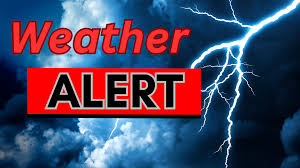“Severe Thunderstorm Warning.”
🌩️ Severe Thunderstorm Warning: What It Means, How to Stay Safe, and Why You Should Never Ignore It
When your phone buzzes or TV screen flashes with a “Severe Thunderstorm Warning”, it’s not something to brush off. These alerts aren’t just about heavy rain—they’re serious life-saving warnings issued by meteorologists when dangerous weather conditions are imminent. Understanding what a Severe Thunderstorm Warning means, and how to respond quickly, could make all the difference between safety and disaster.

⚡ What Is a Severe Thunderstorm Warning?
A Severe Thunderstorm Warning is an urgent alert issued by national weather agencies (like the National Weather Service in the U.S.) when radar or spotters detect a thunderstorm capable of producing:
- Winds of 58 mph (93 km/h) or higher
- Hail that is 1 inch (2.5 cm) in diameter or larger
- Heavy rain leading to flash flooding
- Frequent lightning strikes
Unlike a Severe Thunderstorm Watch, which means conditions might develop, a Warning means the storm is happening or about to happen. That’s when it’s time to act immediately—seek shelter and stay informed.
🌪️ Why You Should Never Ignore a Severe Thunderstorm Warning
Every year, severe thunderstorms cause millions of dollars in damage, power outages, and even fatalities across the world. Many people underestimate them, thinking it’s just another rainstorm. But these storms can intensify rapidly, turning roads into rivers and skies into chaos.
Here’s why you should take every Severe Thunderstorm Warning seriously:
- Hidden Dangers – Even without a tornado, straight-line winds can rip roofs off homes or topple trees.
- Flash Floods Form Fast – Within minutes, water levels can rise and trap vehicles or people.
- Lightning Is Deadly – A single strike can cause fires, power surges, and serious injuries.
- Flying Debris – Hail and wind can shatter glass or cause serious injury if you’re outside.
When the alert comes, treat it as an emergency—not an inconvenience.
🏠 What To Do When a Severe Thunderstorm Warning Is Issued
If you receive a Severe Thunderstorm Warning, follow these safety steps immediately:
1. Seek Shelter Indoors
Move into a sturdy building, away from windows and doors. Avoid mobile homes, sheds, or tents—they’re unsafe during high winds.
2. Stay Away From Electrical Appliances
Unplug sensitive electronics. Lightning can cause dangerous power surges.
3. Avoid Water and Plumbing
Don’t shower, bathe, or wash dishes during a lightning storm. Electricity can travel through plumbing.
4. Stay Informed
Keep a battery-powered weather radio or mobile app ready. Updates may include flash flood or tornado warnings too.
5. Wait Until It’s Over
Don’t rush outside right after thunder stops. Lightning can strike even when the sky seems to be clearing.
🚗 Driving During a Severe Thunderstorm? Here’s What To Do
Driving in severe thunderstorms can be terrifying—and dangerous. If you’re caught on the road when a Severe Thunderstorm Warning is active:
- Pull over safely and stay inside your vehicle.
- Avoid low-lying roads where flooding occurs quickly.
- Do not drive through standing water—just 12 inches can sweep your car away.
- Turn on hazard lights to increase visibility.
Remember the rule: Turn Around, Don’t Drown.
🌧️ After the Storm: Stay Alert for Hidden Hazards
Once the thunderstorm passes, the danger might not be over. Power lines could be down, trees may be unstable, and flash floods can still occur.
Here’s what to check:
- Avoid walking through flooded areas.
- Report downed power lines to authorities.
- Inspect your home for damage safely.
- Stay tuned for follow-up alerts in case more storms are forming.
🌎 Climate Change and the Rise of Severe Thunderstorms
Meteorologists warn that climate change is intensifying severe thunderstorms worldwide. Warmer air holds more moisture, creating stronger updrafts and heavier rainfall. Cities across North America, Europe, and Asia are now seeing more frequent Severe Thunderstorm Warnings than ever before.
The takeaway? Extreme weather is the new normal, and staying prepared is essential for protecting lives and property.
💡 How to Prepare for the Next Severe Thunderstorm Warning
Preparation is key. Here’s how to be ready before the next alert strikes:
- Download a reliable weather app with real-time alerts.
- Create an emergency kit with flashlights, batteries, water, and non-perishable food.
- Secure outdoor items like patio furniture, umbrellas, and garbage bins.
- Make an evacuation plan for your family and pets.
- Review your home insurance policy to ensure storm coverage.
Being proactive could save you stress—and money—when severe weather hits.

📰 Final Thoughts: Take Every Severe Thunderstorm Warning Seriously
A Severe Thunderstorm Warning isn’t just a routine weather update—it’s a direct message to act now. Whether you’re at home, work, or traveling, take immediate safety precautions and stay updated through official channels.
The storms may pass, but being prepared helps you and your loved ones stay safe every time nature shows its power.
✅ SEO Keywords Used Naturally:
Severe Thunderstorm Warning, Severe Thunderstorm Safety, Weather Alerts, Thunderstorm Preparation, Climate Change, Lightning Safety, Flash Flood Warning.